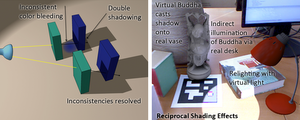Information
- Publication Type: Journal Paper (without talk)
- Workgroup(s)/Project(s):
- Date: November 2012
- ISSN: 0097-8493
- Journal: Computers & Graphics
- Number: 7
- Volume: 36
- Pages: 846 – 856
- Keywords: Differential rendering, Reconstruction, Instant radiosity, Microsoft Kinect, Real-time global illumination, Mixed reality
Abstract
In this paper we present a novel plausible rendering method for mixed reality systems, which is useful for many real-life application scenarios, like architecture, product visualization or edutainment. To allow virtual objects to seamlessly blend into the real environment, the real lighting conditions and the mutual illumination effects between real and virtual objects must be considered, while maintaining interactive frame rates. The most important such effects are indirect illumination and shadows cast between real and virtual objects.Our approach combines Instant Radiosity and Differential Rendering. In contrast to some previous solutions, we only need to render the scene once in order to find the mutual effects of virtual and real scenes. In addition, we avoid artifacts like double shadows or inconsistent color bleeding which appear in previous work. The dynamic real illumination is derived from the image stream of a fish-eye lens camera. The scene gets illuminated by virtual point lights, which use imperfect shadow maps to calculate visibility. A sufficiently fast scene reconstruction is done at run-time with Microsoft's Kinect sensor. Thus a time-consuming manual pre-modeling step of the real scene is not necessary. Our results show that the presented method highly improves the illusion in mixed-reality applications and significantly diminishes the artificial look of virtual objects superimposed onto real scenes.
Additional Files and Images
Weblinks
BibTeX
@article{knecht_martin_2012_RSMR,
title = "Reciprocal Shading for Mixed Reality",
author = "Martin Knecht and Christoph Traxler and Oliver Mattausch and
Michael Wimmer",
year = "2012",
abstract = "In this paper we present a novel plausible rendering method
for mixed reality systems, which is useful for many
real-life application scenarios, like architecture, product
visualization or edutainment. To allow virtual objects to
seamlessly blend into the real environment, the real
lighting conditions and the mutual illumination effects
between real and virtual objects must be considered, while
maintaining interactive frame rates. The most important such
effects are indirect illumination and shadows cast between
real and virtual objects. Our approach combines Instant
Radiosity and Differential Rendering. In contrast to some
previous solutions, we only need to render the scene once in
order to find the mutual effects of virtual and real scenes.
In addition, we avoid artifacts like double shadows or
inconsistent color bleeding which appear in previous work.
The dynamic real illumination is derived from the image
stream of a fish-eye lens camera. The scene gets illuminated
by virtual point lights, which use imperfect shadow maps to
calculate visibility. A sufficiently fast scene
reconstruction is done at run-time with Microsoft's Kinect
sensor. Thus a time-consuming manual pre-modeling step of
the real scene is not necessary. Our results show that the
presented method highly improves the illusion in
mixed-reality applications and significantly diminishes the
artificial look of virtual objects superimposed onto real
scenes.",
month = nov,
issn = "0097-8493",
journal = "Computers & Graphics",
number = "7",
volume = "36",
pages = "846--856",
keywords = "Differential rendering, Reconstruction, Instant radiosity,
Microsoft Kinect, Real-time global illumination, Mixed
reality",
URL = "https://www.cg.tuwien.ac.at/research/publications/2012/knecht_martin_2012_RSMR/",
}


 draft
draft
